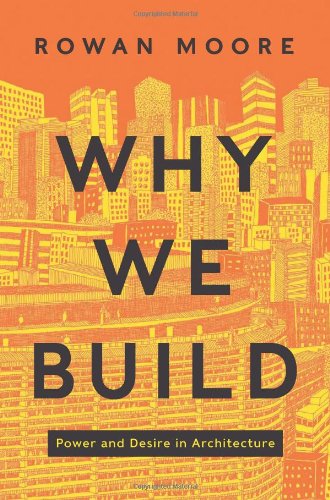
Sinossi
In an era of brash, expensive, provocative new buildings, a prominent critic argues that emotions—such as hope, power, sex, and our changing relationship to the idea of home—are the most powerful force behind architecture, yesterday and (especially) today.
We are living in the most dramatic period in architectural history in more than half a century: a time when cityscapes are being redrawn on a yearly basis, architects are testing the very idea of what a building is, and whole cities are being invented overnight in exotic locales or here in the United States.
Now, in a bold and wide-ranging new work, Rowan Moore—former director of the Architecture Foundation, now the architecture critic for The Observer—explores the reasons behind these changes in our built environment, and how they in turn are changing the way we live in the world. Taking as his starting point dramatic examples such as the High Line in New York City and the outrageous island experiment of Dubai, Moore then reaches far and wide: back in time to explore the Covent Garden brothels of eighteenth-century London and the fetishistic minimalism of Adolf Loos; across the world to assess a software magnate’s grandiose mansion in Atlanta and Daniel Libeskind’s failed design for the World Trade Center site; and finally to the deeply naturalistic work of Lina Bo Bardi, whom he celebrates as the most underrated architect of the modern era.
Le informazioni nella sezione "Riassunto" possono far riferimento a edizioni diverse di questo titolo.
Informazioni sull?autore
Rowan Moore is the architecture critic for The Observer (London); he previously held the same post for The Evening Standard. From 2002 to 2008 he was the director of the Architecture Foundation. In 2013, he was named Critic of the Year by the Society of Editors (UK). A trained architect himself, he lives in London.
Dalla quarta di copertina
In an era of brash, expensive, provocative new buildings, a prominent critic argues that emotions hope, power, sex, our changing relationship to the idea of home are the most powerful force behind architecture, yesterday and (especially) today.
We are living in one of the most dramatic periods in modern architectural history: a time when cityscapes are being redrawn on a yearly basis, architects are testing the very idea of what a building is, and whole cities are being invented overnight, both here in the United States and in exotic locations around the world.
In this bold and wide-ranging new work, Rowan Moore former director of the Architecture Foundation, now a leading architecture critic explores the reasons behind these changes in our built environment, and how they in turn are changing the way we live in the world. Taking as his starting point dramatic examples such as the High Line in New York City and the outrageous island experiment of Dubai, Moore then reaches far and wide: back in time to explore the Covent Garden brothels of eighteenth-century London and the fetishistic minimalism of Adolf Loos; across the world to assess a software magnate's grandiose mansion in Atlanta and Daniel Libeskind's failed design for the World Trade Center site; and finally to the deeply naturalistic work of Lina Bo Bardi, whom he celebrates as the most underrated architect of the modern era.
Provocative and personal, iconoclastic and transforming, Why We Build is that rarest of things: a book about architecture that is also, on every page, a book about people those chosen few who design buildings, and the rest of us, who use them every day.
Le informazioni nella sezione "Su questo libro" possono far riferimento a edizioni diverse di questo titolo.
Altre edizioni note dello stesso titolo
Risultati della ricerca per Why We Build: Power and Desire in Architecture
Why We Build : Power and Desire in Architecture
Da: Better World Books, Mishawaka, IN, U.S.A.
Condizione: Very Good. Former library book; may include library markings. Used book that is in excellent condition. May show signs of wear or have minor defects. Codice articolo GRP92558072
Compra usato
Quantità: 2 disponibili
Why We Build
Da: -OnTimeBooks-, Phoenix, AZ, U.S.A.
Condizione: good. A copy that has been read, remains in good condition. All pages are intact, and the cover is intact. The spine and cover show signs of wear. Pages can include notes and highlighting and show signs of wear, and the copy can include "From the library of" labels or previous owner inscriptions. 100% GUARANTEE! Shipped with delivery confirmation, if you're not satisfied with purchase please return item for full refund. Ships via media mail. Codice articolo OTV.0062277537.G
Compra usato
Quantità: 1 disponibili
Why We Build
Da: Midtown Scholar Bookstore, Harrisburg, PA, U.S.A.
hardcover. Condizione: Very Good. With very good dust jacket. Very Good hardcover with light shelfwear - NICE! Standard-sized. Codice articolo mon0000298855
Compra usato
Quantità: 1 disponibili
Why We Build
Da: Clevebookseller, Mantua, OH, U.S.A.
Condizione: Good. 2013 HCw/DJ. Withdrawn library copy set in mylar. Little library signage. Clean. Codice articolo 10374
Compra usato
Quantità: 1 disponibili
Why We Build
Da: The Book Spot, Sioux Falls, MN, U.S.A.
Hardcover. Condizione: New. Codice articolo Abebooks61678
Compra nuovo
Quantità: 1 disponibili
Why We Build: Power and Desire in Architecture
Da: Revaluation Books, Exeter, Regno Unito
Hardcover. Condizione: Brand New. 392 pages. 9.50x6.25x1.50 inches. In Stock. Codice articolo 0062277537
Compra nuovo
Quantità: 1 disponibili

